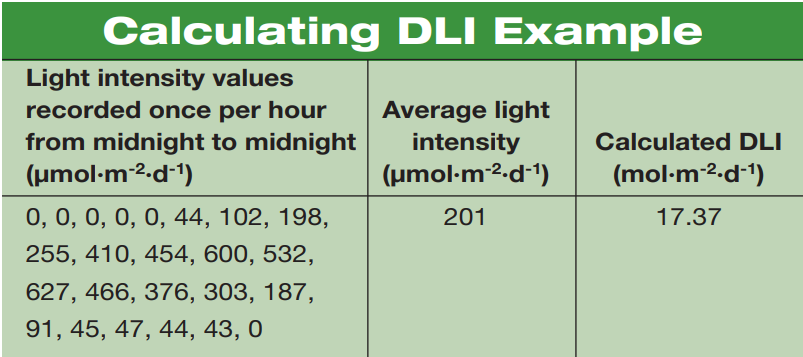
Do you know what your DLI is?
DOWNLOADDecember 24, 2006 - E. Runkle
technically speaking By Erik Runkle
Do You Know What Your DLI Is?
Daily light integral has a profound effect on your plants. Learn how to measure DLI in your greenhouse three different ways.
In
last month’s column, I discussed the definition of daily light integral (DLI). Just to refresh your memory, DLI is the cumulative amount of photosynthetic light that is received each day. The DLI is measured as the number of moles of light (mol) per square meter (m-2) per day (d-1), or mol·m-2·d-1. The DLI can have a profound effect on root and shoot growth of seedling plugs, root development of cuttings and finish plant quality attributes such as stem thickness, plant branching and flower number.
The average DLI received outdoors ranges roughly from 5 to 60 mol·m-2·d-1 and depends on location and time of year. Inside a greenhouse, light transmission is usually reduced 35- 50 percent, so it is not uncommon to have an average DLI inside a greenhouse less than 3 mol·m-2·d-1 in the northern United States and Canada during the darkest periods of the year. In general, 4-6 mol·m-2·d-1 is recommended for propagation of cuttings and at least 10-12 mol·m-2·d-1 is recommended for most bedding plants, perennials and potted crops.
Measuring Your DLI
There are three ways to estimate the DLI in your greenhouse. The most accurate method is to use a light sensor to measure light intensity at least once every 10 minutes and then have the values automatically logged onto a computer. Many environmental control systems have the ability to record light intensity, but often times, the light sensor is located outside the greenhouse. A light sensor used to measure DLI should be positioned inside the greenhouse at plant level where the plants are growing. In addition, the output of the light sensor should be in a photometric unit, µmol·m-2·s-1. This unit allows the summation into mol·m-2·d-1.
Once light intensity has been measured frequently and with an output in µmol·m-2·s-1, it then can be converted to a DLI value in mol·m-2·d-1. To do this, the average 24-hour light intensity (from midnight to midnight) should first be determined. Next, the average value should be multiplied by 0.0864 to get the DLI for that day. This constant number is derived by multiplying 3,600 (number of seconds in one hour) by 24 (number of hours in one day) and then dividing the value by one million (the number of µmol in 1 mol).
Let’s illustrate this exercise by looking at the values in Figure 1, below. In this example, light was measured once every hour. The calculated average of these 24 values was determined to be 201 µmol·m-2·d-1. To convert this average value into a DLI, it is multiplied by 0.0864, and the outcome is 17.3664, which can then be rounded to 17.4 mol·m-2·d-1.

More Measurement Methods
An easier way to measure DLI is to use the Greenhouse Weather Tracker by Spectrum Technologies (www.spec meters.com). This unit contains a light sensor and can be placed next to the plants. This device records light intensity, performs the mathematics and outputs the DLI value in mol·m-2·d-1. The newest version of the WatchDog data logger can be connected to a serial port on a computer so the data can be downloaded electronically.
The DLI at your location can also be estimated using DLI maps that were developed by Jim Faust at Clemson University. He determined the average DLI outdoors during every month for the contiguous United States. The maps are in several floriculture texts and can also be found online at www.hrt.msu. edu/floraoe/dlimaps.htm. The values outdoors need to be converted into realistic values inside your greenhouse. To do this, use a light sensor to determine light intensity outdoors at noon on a clear day. Then go into your greenhouse and take measurements at plant level. Use these values to determine the percentage of light outdoors that reaches your crops. For example, if you measure 6,300 foot-candles outside the greenhouse and an average value of 4,100 foot-candles inside, your light transmission value is about 65 percent. If the DLI maps indicate your average outdoor DLI is 10-15 mol·m-2·d-1, then you can estimate that your average DLI at plant level is about 6-10 mol·m-2·d-1.
Erik Runkle is assistant professor and floriculture extension specialist in the Department of Horticulture at Michigan State University. He can be reached at runkleer@msu.edu or (517) 355-5191.



 Print
Print Email
Email





